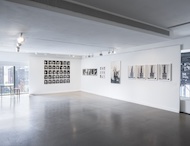Before even entering the Independent art fair, which is back at Tribeca’s Spring Studios after decamping to the Financial District in 2021, visitors get a taste of one of the great strengths of this year’s fair: an arresting, decades-old photograph by an under-recognised artist. In this case the artist is Martine Barrat, a French, New York-based photographer now in her late 80s whose black-and-white photograph of a reveller leaving Harlem’s Amsterdam Music Club early one morning in 1982 has been printed onto one of the building’s exterior windows.
Just inside the fair, Miami-based gallery Nina Johnson has a solo stand of Barrat’s photos (priced between $12,000-$32,000), most of which capture New York City street scenes in the early 1980s. Many of the images have the composition, candour and spontaneity of classic street photography, but there is also a degree of familiarity, grandeur and even performance in some that evokes Dawoud Bey’s seminal Harlem, USA series of a few years earlier. Or, as Yves Saint Laurent once said of Barrat’s work, “This photographer has a special eye, an eye that sees from the heart. She knows how to capture the unique moment that says it all.”
At the Higher Pictures Generation stand, the “new” is a grid of 35 black-and-white self-portraits from 1977 (priced at $25,000) by the British, New York-based photographer and dealer Janice Guy. Many in the New York art world know Guy best as one half of the since-shuttered Chelsea gallery Murray Guy, which represented pathbreaking photographers such as Moyra Davey and An-My Lê.
“When she moved to New York she changed her medium into a gallery,” says Kim Bourus, owner of Higher Pictures Generation. The large grid, which has never been exhibited publicly before, was kept in storage for years along with most of Guy’s photographic oeuvre by the artist Thomas Strüth, her classmate at the Kunstakademie Düsseldorf, where she studied with Klaus Rinke and Bernd and Hilla Becher. Their penchant for seriality is evident in Guy’s photos here, most of which are installed as grids or series, although she favours self-portraits over industrial architecture.
Another artist working in photography who has long been left out of the broader history of the Pictures Generation, Jennifer Bolande, has a solo stand with Magenta Plains. Her works on view span 2014 to the early 1980s, and reflect a conceptual interest in photography and appropriated imagery. The earliest works, from her Porn Series (1982-83), are small, inscrutable images of generic domestic interiors. They are based on frames from vintage adult films that were shown during late-night screenings at the cinema where Bolande worked, which she cut from the films and developed as photographic miniatures. They provide a prelude to the more recent and larger works on view nearby.
“She was related to the Pictures Generation, but hasn’t gotten the level of attention many of those artists have,” explains a member of the gallery staff, adding that visitors to Independent have a level of fluency with photography that is not a given at every fair. “There’s a strong knowledge of the techniques of photography among the collectors at this fair. We’ve been getting questions about cameras, editions and printing techniques.”
Two stands over, Paris-based Galerie Sultana has paired canvases by the emerging British painter Celia Hempton with photographs by the Swiss photographer Walter Pfeiffer spanning the 1980s to this year (priced between €5,000 and €9,500). His images, which include still lifes and partially obscured portraits of male figures, juxtapose well with Hempton’s enigmatic figurative canvases. For gallery founder Guillaume Sultana, the presentation at Independent and a major Pfeiffer exhibition that just opened at the Swiss Institute make for an opportunity to showcase the artist’s influential role in a transitional moment in photography.
“He started out in the 1960s and 70s, in the middle of the passage from black-and-white photography to colour, and he was in conversation with the earlier generation,” Sultana says. “But he also served as inspiration for a lot of the photographers working in colour who came after.”
Older works by other influential photographers, some better known than others, are on view throughout Independent. Maureen Paley has a salon-style installation that includes photos by Peter Hujar and Wolfgang Tillmans. Bucharest-based Ivan Gallery is showing photos from the 1970s by the Romanian artist Ion Grigorescu. And Vienna-based Galerie Hubert Winter’s stand includes an engrossing presentation of works by the late Austrian avant-garde feminist artist Birgit Jürgenssen. It includes photographs of playful, subversive performances and interventions, such as Nest (1979/2002, priced at $15,000), in which the artist appears nude with a bird’s nest containing two small eggs cradled in her crotch.
For Dee, the prevalence of historical photography at the fair this year is a symptom of resurgent collector interest in the medium—which she attributes, in part, to a surprising factor. “The photography market has been largely stagnant for the past decade, but the pendulum is swinging all the way back in the opposite direction,” she says. “I think that is partly due to NFTs (non-fungible tokens), which have made collectors a lot more comfortable with the concept of editions—people who buy NFTs see everything through the lens of collectibles, rather than unique objects.”

